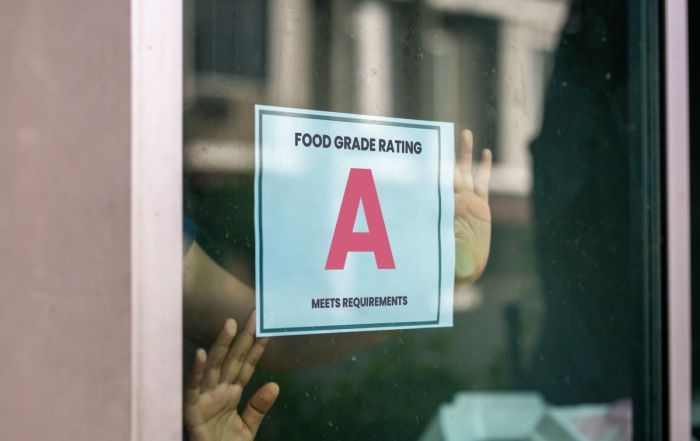When Temperatures Rise, Keep Food Safety Top of Mind
Summer brings a welcome increase in business for many restaurants, catering services, and event venues. It certainly did for the restaurant that I used to manage. With outdoor dining, festivals, weddings, and seasonal traffic, foodservice operations often experience their busiest stretch between Memorial Day and Labor Day. And the warmer weather creates ideal conditions for bacteria to grow quickly.
In our restaurant, it was even more of a challenge because our back kitchen was not air-conditioned. With the heat at the peak of summer often reaching the high 80s, our back kitchen would often top the 100-degree mark.
The Centers for Disease Control and Prevention does note that foodborne illness rates tend to spike during summer months. Keep in mind these rates are heavily influenced by consumer food preparation, and the average consumer does tend to prepare food outside more during the summer, which is away from refrigeration and water sources that are important for handwashing and general cleanliness. Anecdotally, it also seems that most tend to neglect to use thermometers when grilling or barbequing, which also contributes to this increase in foodborne illness rates.
That doesn’t mean that those of us in foodservice are off the hook. While the spike in foodborne illnesses during the summer is influenced by consumers, warmer temperatures create ideal conditions for bacteria to grow rapidly, and busy kitchens may find it harder to maintain strict time and temperature controls. And for those kitchens that have poor or no air-conditioning, like the back kitchen at the restaurant I managed, it is even more problematic. We also tend to see an increase in off-site and outdoor catering requests during the summer, which are always challenging for food safety, just as they are for the average person grilling outdoors at home. For foodservice operators, now is the time to double down on best practices to protect your customers.
…Maintaining proper temperatures is one of the most effective ways to prevent foodborne illness. Cold foods must be kept at 41°F (5°C) or below, while hot foods must stay at 135°F (57°C) or above.
Maintaining proper temperatures is one of the most effective ways to prevent foodborne illness. Cold foods must be kept at 41°F (5°C) or below, while hot foods must stay at 135°F (57°C) or above. Use calibrated thermometers regularly and ensure holding units and refrigeration equipment are functioning correctly, especially on those hot days when they’re under more strain.
Remind staff that the “danger zone” between 41°F and 135°F is where bacteria multiply rapidly. Even short exposures, such as during delivery, prepping, or buffet service, can be risky if not closely monitored.
If you’re offering outdoor dining or catering for off-site events, take extra precautions. Transport perishable items in insulated containers with ice packs or refrigeration units. At events, ensure you have safe food handling stations with handwashing access, and always cover food to protect it from insects and environmental contaminants.
With staff turnover often higher in summer, especially with seasonal hires, consistent hygiene practices can slip. Conduct brief, regular refreshers on handwashing procedures, glove use, and staying home when sick. Providing accessible handwashing stations and fully stocked hygiene supplies can go a long way in helping to improve proper food safety practices and helping employees to maintain compliance with identified standards.
Encourage a culture where safety comes first. I know this is something we seem to include in most of our blogs, but it is vital to ensuring proper food safety in your establishment. Empower your team to speak up if they see something concerning, and reward attention to detail.
Now is a great time to revisit your food safety plan and ensure staff are trained and procedures are up to date. Consider a mid-season check-in to evaluate what’s working and what might need adjustment during peak operations. Risk Nothing.
READ MORE POSTS
Embracing Technology for Enhanced Food Safety in Foodservice Operations
Technology. We love it, we hate it. I’ve always been fascinated by technology; I remember getting my first Blackberry in the mid-90s and thinking it was the pinnacle of technological advances. Before that, I remember ordering a dictation program in college that was going to revolutionize the way I “typed” my assignments. Looking back, it really wasn’t worth the box that the program came in. Now, we have ChatGPT that will write the entire paper for us!
Meat Color and Doneness: Persistent Pinking
Late in June, my family and I were able to visit the Black Hills, an area of the country in which I have not had the opportunity to spend much time. One evening, as we dined at a local restaurant, I observed a table across the dining room sending back a dinner. While I couldn’t hear the entire conversation and I certainly wasn’t trying to eavesdrop, it was apparent that the customer was unhappy with the cooking of their hamburger and was sending it back because it was too pink in the middle. That immediately brought to my mind the phenomenon known as persistent pinking. A term I became familiar with because of work done by some colleagues here at Kansas State, which they present each summer to a group of foodservice operators who join us on-campus for an in-depth week-long look at all things food safety.
Quat Binding – Why this Can Have a Disastrous Impact on Your Sanitation Program.
In June, I had the opportunity to represent FoodHandler and speak on food safety behavior for customers of Martin Bros. Distributing in Waterloo, Iowa. One of the questions that was asked caught me a little off guard. The question was about quat binding. It caught me off guard not because it was a bad question, but only because it was not something I had previously been asked nor had not yet been exposed to the phenomenon. However, I soon learned that in certain jurisdictions, it is resulting in changes to how sanitizing cloths are to be stored in sanitizing buckets (or not) in the foodservice industry. When I returned home from the trip, I had to dig into it to learn about what quat binding is and how it might impact foodservice operations.
Are Grades for Foodservice Inspections a Good Idea?
I generally try to stay away from controversial topics in my blog, but this is one I thought it might be interesting to discuss. Occasionally on my travels, I will come across a state or a local jurisdiction that requires foodservice inspection scores be posted in the window of the establishment. The idea is to allow would-be customers the ability to see how the foodservice operation in which they are about to eat scored on their latest health inspection.










